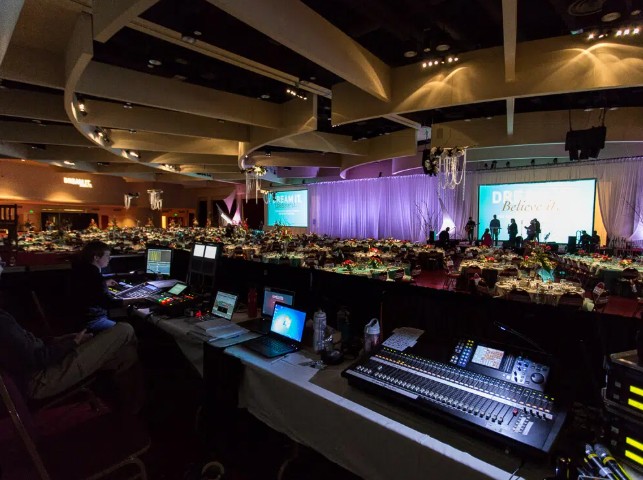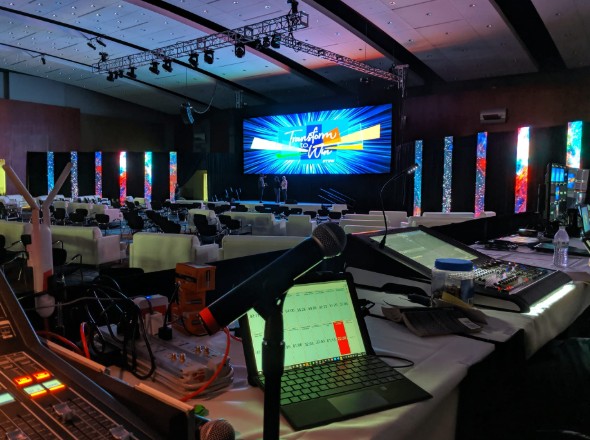In the heart of a bustling convention center, a CEO steps onto the stage to unveil a revolutionary product. The audience leans forward in anticipation. But as she begins to speak, the microphone emits a piercing screech, then falls silent. Technicians scramble behind the curtains while attendees exchange awkward glances. This scenario, which plays out more often than we’d like to remember, underscores a fundamental truth in event planning: your audiovisual system isn’t just another item on your checklist—it’s the central nervous system of your entire event.
A flawless audiovisual (AV) experience does more than simply amplify sound and display images—it creates atmosphere, builds emotion, facilitates connection, and transforms passive observers into engaged participants. Whether you’re planning an intimate workshop, a corporate conference, a live-streamed product launch, or a full-scale musical performance, understanding how to design, implement, and manage your AV system is what separates memorable events from forgettable ones.
This comprehensive guide synthesizes insights from leading industry experts to bring you a complete framework for AV excellence. We’ll walk through every stage of the process, from initial assessment to post-event breakdown, ensuring you have the knowledge to create stunning audiovisual experiences that captivate your audience and amplify your message.

Why AV Quality Determines Event Success
The impact of professional audiovisual production extends far beyond basic functionality. Research in event psychology shows that audiences form subconscious judgments about an event’s quality within the first seven seconds—judgments heavily influenced by what they see and hear.
The Multisensory Experience:
Modern attendees don’t just want to receive information; they want to experience it. A well-orchestrated AV setup engages multiple senses simultaneously, creating neural connections that enhance memory retention and emotional impact. When sound, vision, and lighting work in harmony, they transform abstract concepts into tangible experiences.
The Credibility Factor:
Technical glitches don’t just cause temporary interruptions—they undermine your perceived competence. A study by Event Manager Blog found that 68% of attendees would think twice about returning to an event where they experienced significant AV problems. Conversely, seamless production values subconsciously communicate professionalism and attention to detail.
The Engagement Economy:
In an age of diminishing attention spans, your AV system is your primary weapon against distraction. Dynamic visuals, crystal-clear audio, and atmospheric lighting work together to create what psychologists call “flow states”—periods of deep engagement where audiences lose track of time and become fully immersed in your content.
Phase 1: Foundational Planning & Assessment
1.1 Understanding Your Event’s Unique AV DNA
Before selecting a single piece of equipment, you must develop a comprehensive understanding of your event’s specific requirements. This goes beyond basic questions about audience size and venue type—it requires a holistic view of your event’s purpose, content, and audience expectations.
Content Analysis Framework:
- Presentation Styles:Will you have single speakers, panel discussions, or audience Q&A sessions? Each requires different microphone configurations and mixing approaches.
- Media Types:Are you displaying slide decks, video packages, live demonstrations, or data visualizations? Each has distinct resolution, aspect ratio, and brightness requirements.
- Interactive Elements:Will you incorporate live polling, augmented reality experiences, or social media walls? These require robust networking infrastructure and specialized software integration.
Audience Profiling Matrix:
- Demographic Considerations: Younger audiences often expect higher production values and more visual stimulation, while professional audiences may prioritize clarity and information density.
- Accessibility Requirements: Always account for attendees with visual or hearing impairments. This may involve closed captioning systems, assistive listening devices, or reserved seating areas with optimal sightlines.
- Engagement Patterns: Will attendees be stationary or moving around? A trade show environment requires distributed audio zones, while a conference main stage needs focused coverage.
1.2 The Art and Science of Venue Assessment
Your venue isn’t just a container for your event—it’s an active component of your AV system. A thorough venue assessment should be conducted weeks before equipment selection, ideally with your lead technician present.
Acoustic Mapping:
- Use a smartphone decibel meter app to establish baseline noise levels at different times of day
- Conduct clap tests to identify reflection points and standing wave patterns
- Note hard surfaces (glass, concrete) that cause reverberation and soft surfaces (curtains, carpets) that absorb sound
- Identify potential noise sources: HVAC systems, nearby traffic, kitchen facilities
Visual Environment Analysis:
- Measure ambient light levels at different times of day using a light meter app
- Identify potential glare sources and obstructions to sightlines
- Document ceiling heights and load-bearing capacities for rigging points
- Map power outlet locations and circuit capacities
Structural Considerations:
- Floor load capacity for heavy equipment and staging
- Ceiling rigging points and weight limitations
- Cable run paths between front-of-house and stage areas
- Emergency exit locations and safety regulations
Professional Assessment Toolkit:
- Laser distance measure for accurate room dimensions
- Circuit analyzer to verify electrical integrity
- Network cable tester for internet-dependent elements
- RF spectrum analyzer for wireless frequency planning
Phase 2: Equipment Selection & System Design
2.1 Audio Systems: The Foundation of Engagement
Your audio system does more than make people heard—it establishes emotional tone and ensures message comprehension.
Microphone Selection Matrix:
- Lavalier Microphones:Ideal for speakers who gesture with their hands. Choose omnidirectional for natural sound or directional for noisy environments.
- Handheld Wireless:Perfect for audience Q&A or interactive sessions. Consider throwable options like CatchBox for high-energy events.
- Headset Microphones:Essential for speakers who need complete hands-free operation, such as performers or demonstration hosts.
- Boundary Microphones:Excellent for capturing panel discussions without cluttering the stage with stands.
Speaker System Architecture:
- Point Source Systems: Suitable for smaller, rectangular rooms where all listeners are roughly the same distance from the source.
- Line Array Systems: Essential for large spaces or challenging acoustics, providing even coverage from front to back.
- Distributed Systems: Perfect for breakout sessions, exhibitions, or venues with multiple zones of activity.
- Monitor Systems: Critical for keeping presenters and performers connected to their audio environment.
Signal Processing & Mixing:
Modern digital mixers offer unprecedented control with features like:
- Automatic feedback suppression
- Room EQ optimization via built-in analyzers
- Multitrack recording capabilities
- Remote control via tablet or computer
2.2 Visual Systems: Creating Visual Impact
Your visual system transforms abstract concepts into memorable imagery and ensures everyone can engage with your content, regardless of their seating position.
Display Technology Selection Guide:
| Technology |
Best For |
Brightness |
Setup Considerations |
| Front Projection |
Large, controllable environments |
5,000-20,000 lumens |
Requires controlled lighting, throw distance calculation |
| Rear Projection |
Professional presentations |
5,000-15,000 lumens |
Needs significant depth behind screen, eliminates shadows |
| LED Walls |
High-impact, bright environments |
Self-illuminating |
Modular setup, excellent for complex shapes |
| LCD/LED Displays |
Small to medium meetings |
Backlit technology |
Simple installation, works in various lighting conditions |
Aspect Ratio Strategy:
- 16:9 Widescreen:The modern standard for video content and computer presentations
- 16:10 Computer Standard:Common for business laptops, requires scaling or pillarboxing
- 4:3 Legacy Format:Still found in some older venues and content, increasingly rare

Kinglight – professional LED supplier
Resolution Hierarchy:
- 1080p (Full HD):Minimum acceptable standard for most corporate events
- 2K/4K (UHD):Becoming the new standard for high-impact presentations
- 8K and Beyond:Currently limited to specialized applications due to content and bandwidth constraints
2.3 Lighting Design: Setting the Emotional Tone
Lighting does more than illuminate—it directs attention, creates mood, and reinforces branding.
Essential Lighting Categories:
- Key Lights:Primary illumination for speakers and presentation areas
- Fill Lights:Reduce shadows and create depth
- Back Lights:Separate subjects from background, creating visual pop
- Ambient Lights:Establish base level illumination for safety and comfort
- Special Effects:Moving heads, patterns, and color washes for dramatic impact
Control Systems:
- DMX Protocol:Industry standard for professional lighting control
- Architectural Integration:Tie-in with house lighting systems when available
- Preset Programming:Create and save looks for different segments of your event
2.4 Signal Management & Infrastructure
The invisible backbone of your AV system—what happens between sources and displays—often determines overall reliability.
Cable Management Framework:
- Signal Types:HDMI for digital video, XLR for balanced audio, Ethernet for control and data
- Length Considerations:Signal degradation occurs over distance—use signal boosters or fiber optic extenders for runs over 50 feet
- Redundancy Planning:Always run backup cables for mission-critical connections
- Safety Implementation:Use cable ramps, gaffer tape, and proper strain relief
Distribution Systems:
- Matrix Switchers: Allow any source to be routed to any display
- DA (Distribution Amplifiers): Split signals to multiple destinations without quality loss
- Format Converters: Bridge between different signal standards and resolutions
Phase 3: Pre-Event Preparation
3.1 The Comprehensive AV Checklist
A detailed checklist serves as your project roadmap and quality assurance tool.
Equipment Inventory Section:
- Categorize by type, quantity, and specific model numbers
- Include serial numbers for rental equipment tracking
- Note firmware versions for digital equipment
- Document accessory requirements (batteries, cables, mounts)
Connection Documentation:
- Create detailed input/output matrices
- Document cable labeling schemes
- Provide signal flow diagrams for complex systems
- Include patch lists for audio systems
Personnel Coordination:
- Contact information for all team members
- Role definitions and responsibility assignments
- Communication protocols and chain of command
- Emergency contact information for vendors and venue staff
3.2 Technical Rehearsal Protocol
The rehearsal isn’t just a quick sound check—it’s a systematic validation of your entire system.
Audio Validation Sequence:
- Line check all microphones and sources
- Set gain structure and monitor levels
- Test emergency backup systems
- Verify recording and streaming feeds
- Conduct walk-through audio testing with team members in all seating areas
Visual Quality Assurance:
- Test all content types from actual presentation computers
- Verify color accuracy and brightness uniformity
- Check sightlines from extreme seating positions
- Confirm lower-third graphics and branding elements
Failure Simulation Drills:
- Intentionally fail primary systems to verify backup activation
- Practice rapid microphone replacement during simulated presentations
- Test power redundancy under load conditions
- Simulate network failure for internet-dependent elements
Phase 4: Event Execution & Management
4.1 The Event Day Playbook
Your event day requires military precision combined with creative flexibility.
Pre-Event Timeline:
- 4 Hours Out:System power-up and basic functionality check
- 2 Hours Out:Presenter arrival and individual comfort checks
- 1 Hour Out:Final audio level setting and content verification
- 30 Minutes Out:Show mode activation and team communication check
- 15 Minutes Out:Final systems status confirmation
Communication Infrastructure:
- Primary: Wired intercom systems for critical communications
- Secondary: UHF two-way radios for mobile team members
- Tertiary: Group messaging apps for non-time-sensitive updates
- Emergency: Designated phone lines for venue security and medical services
4.2 Real-Time Monitoring & Adjustment
During the event, your technical team should operate like an air traffic control center—constantly monitoring, anticipating, and adjusting.
Audio Monitoring Points:
- Front-of-house mix position
- Room coverage check positions
- Recording/streaming feed quality
- Backstage monitor world
Visual Quality Control:
- Continuous sightline verification
- Content formatting checks
- Lighting temperature and level adjustments
- Camera framing for IMAG or recording
Audience Engagement Metrics:
- Noise level and response patterns
- Visual attention direction
- Movement and engagement behaviors
- Social media activity related to AV elements

Phase 5: Advanced Considerations
5.1 Hybrid & Virtual Integration
Modern events increasingly blend physical and digital audiences, requiring sophisticated approach to integration.
Streaming Architecture:
- Dedicated encoding hardware for reliability
- Redundant internet connections with automatic failover
- Integrated audience interaction platforms
- Professional commentary and moderation positions
Virtual Audience Experience:
- Multiple camera angles with professional switching
- Dedicated audio mix for remote participants
- Interactive elements like live Q&A and polling
- Virtual networking and exhibition spaces
5.2 Emerging Technologies
Stay ahead of the curve by understanding where event technology is heading.
Immersive Experiences:
- 360-degree projection mapping
- Spatial audio for three-dimensional soundscapes
- Holographic displays for dramatic presentations
- Augmented reality audience applications
AI-Enhanced Production:
- Automated camera tracking and framing
- Intelligent audio mixing and feedback prevention
- Predictive technical issue identification
- Real-time content optimization based on audience response
Phase 6: Post-Event Excellence
6.1 Systematic Breakdown & Inventory
The conclusion of your event requires the same discipline as its setup.
Documentation Protocol:
- Photograph setup details for future reference
- Update equipment lists with performance notes
- Document any issues encountered and solutions applied
- Create “lessons learned” summary for the production team
Feedback Collection:
- Technical team debrief within 24 hours
- Presenter and client feedback sessions
- Audience survey analysis focusing on AV experience
- Vendor performance evaluation
Conclusion: Mastering the Art and Science of AV
Exceptional audiovisual production represents the perfect marriage of technical precision and creative vision. It’s not about having the most expensive equipment or the flashiest effects—it’s about understanding how sight and sound work together to support your event’s goals and create meaningful connections with your audience.
The most successful AV professionals think like architects—designing robust systems with multiple layers of redundancy. They act like psychologists—understanding how different sensory experiences affect audience perception and engagement. And they operate like conductors—orchestrating multiple technical elements into a harmonious whole that serves the event’s content and creators.
By implementing the frameworks and strategies outlined in this guide, you’ll be equipped to transform your events from simple gatherings into immersive experiences that inform, inspire, and endure in memory long after the last screen fades to black.
Remember: Great audiovisual production goes unnoticed when executed perfectly, but becomes the center of attention when anything goes wrong. Your mission is to create the invisible framework that makes magic seem effortless—and with careful planning, systematic execution, and relentless attention to detail, you’ll consistently deliver experiences that exceed expectations and create lasting impact.


